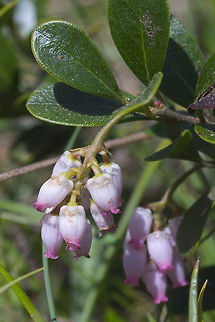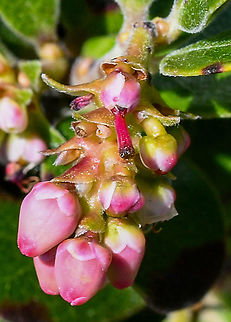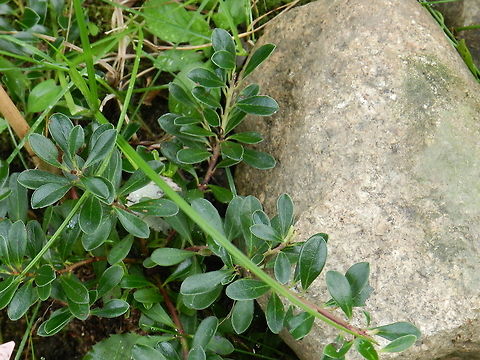
Appearance
''Arctostaphylos uva-ursi'' is a small procumbent woody groundcover shrub 5–30 cm high. The leaves are evergreen, remaining green for 1–3 years before falling. The fruit is a red berry.The leaves are shiny, small, and feel thick and stiff. They are alternately arranged on the stems. Undersides of leaves are lighter green than on the tops. New stems can be red if the plant is in full sun, but are green in shadier areas. Older stems are brown. In spring, they have white or pink flowers.
Pure stands of ''Arctostaphylos uva-ursi'' can be extremely dense, with heights rarely taller than 6 inches. Erect branching twigs emerge from long flexible prostrate stems, which are produced by single roots. The trailing stems will layer, sending out small roots periodically. The finely textured velvety branches are initially white to pale green, becoming smooth and red-brown with maturity. The small solitary three scaled buds are dark brown.
The simple leaves of this broadleaf evergreen are alternately arranged on branches. Each leaf is held by a twisted leaf stalk, vertically. The leathery dark green leaves are an inch long and have rounded tips tapering back to the base. In fall, the leaves begin changing from a dark green to a reddish-green to purple.
Terminal clusters of small urn-shaped flowers bloom from May to June. The perfect flowers are white to pink, and bear round, fleshy or mealy, bright red to pink fruits called drupes. This smooth, glossy skinned fruit will range from 1/4 to 1/2 inch in diameter. The fruit will persist on the plant into early winter. Each drupe contains 1 to 5 hard seeds, which need to be scarified and stratified prior to germination to reduce the seed coat and break embryo dormancy. There is an average of 40,900 cleaned seeds per pound.

Naming
There are at least five reported subspecies:⤷ ''Arctostaphylos uva-ursi'' subsp. ''uva-ursi''. Common bearberry; circumpolar arctic and subarctic, and in mountains further south.
⤷ ''Arctostaphylos uva-ursi'' subsp. ''adenotricha''. Central high Sierra Nevada.
⤷ ''Arctostaphylos uva-ursi'' subsp. ''coactilis''. North coastal California, central coast California, San Francisco Bay Area.
⤷ ''Arctostaphylos uva-ursi'' subsp. ''cratericola'' P. V. Wells. Guatemala bearberry, endemic to Guatemala at very high altitudes .
⤷ ''Arctostaphylos uva-ursi'' subsp. ''longifoliosa''. Various reports from Canada, U.S.A. May be the same as ''adenotricha'' or ''coactilis''.
Sources do not agree on the list of subspecies, so some of these may be identical, or may be separate species rather than subspecies. See bearberry and manzanita. For a list of reported North American subspecies and varietals see ''USDA Plants Profile'' in External Links below. For a complete list of related plants see ''Arctostaphylos''.
⤷ **''Further research needed to clarify botanical classification''***.

Distribution
The distribution of ''Arctostaphylos uva-ursi'' is circumpolar, and it is widespread in northern latitudes, but confined to high altitudes further south:⤷ in Europe, from Iceland and North Cape, Norway south to southern Spain ; central Italy and northern Greece ;
⤷ in Asia from arctic Siberia south to Turkey, the Caucasus and the Himalaya;
⤷ in North America from arctic Alaska, Canada and Greenland south to California, north coast, central High Sierra Nevada , Central Coast, California, San Francisco Bay Area, to New Mexico in the Rocky Mountains; and the Appalachian Mountains in the northeast United States.
In some areas the plant is endangered or has been extirpated from its native range. In other areas, such as the Cascade Range, it is abundant.
References:
Some text fragments are auto parsed from Wikipedia.